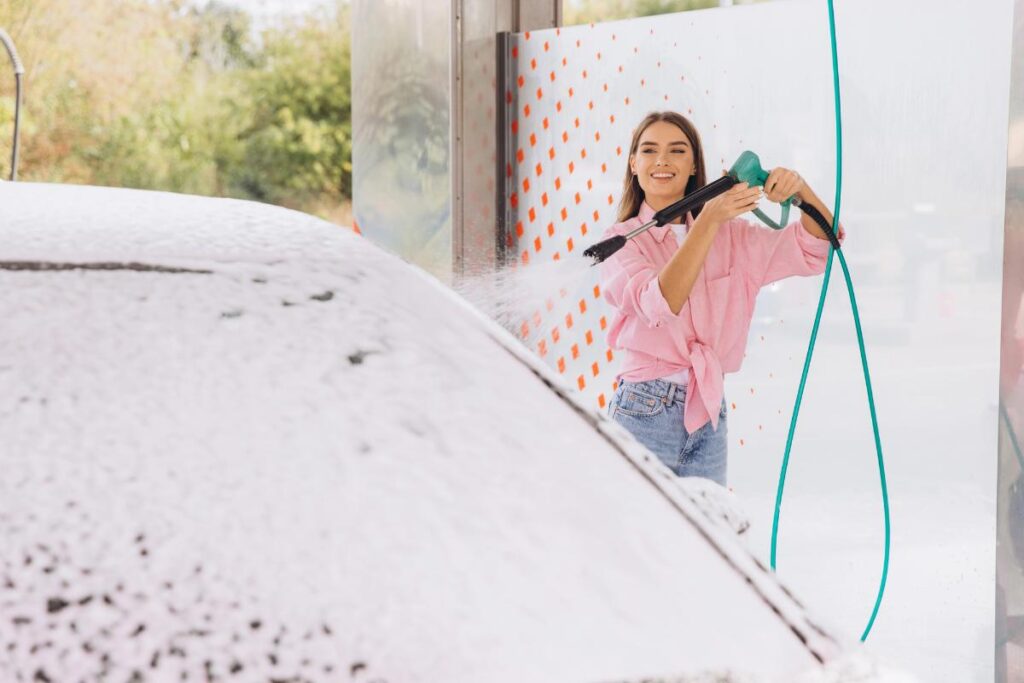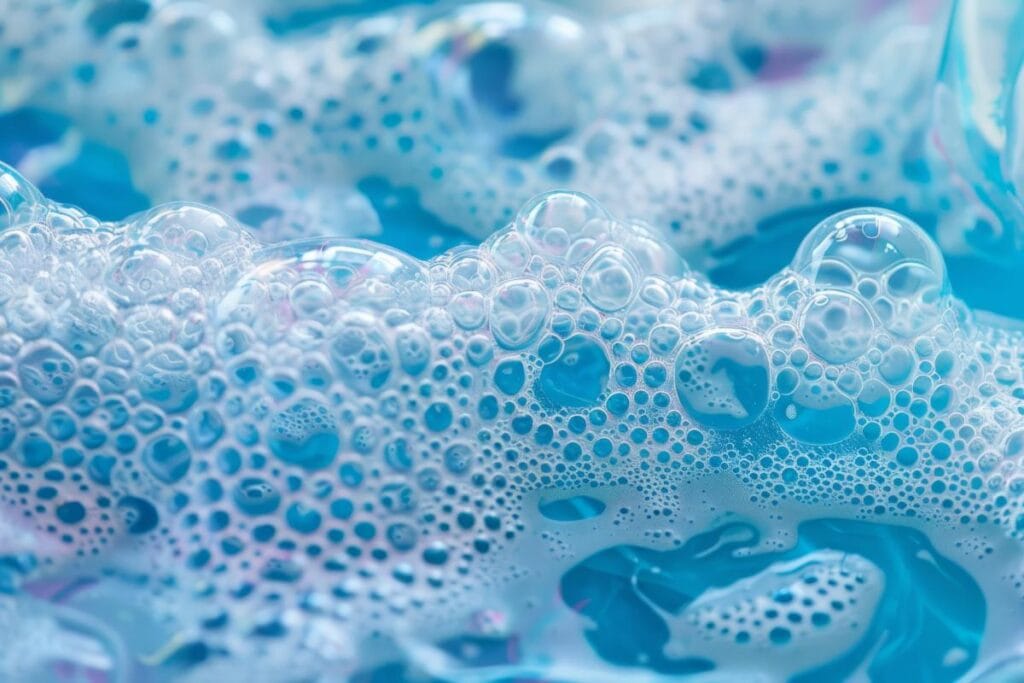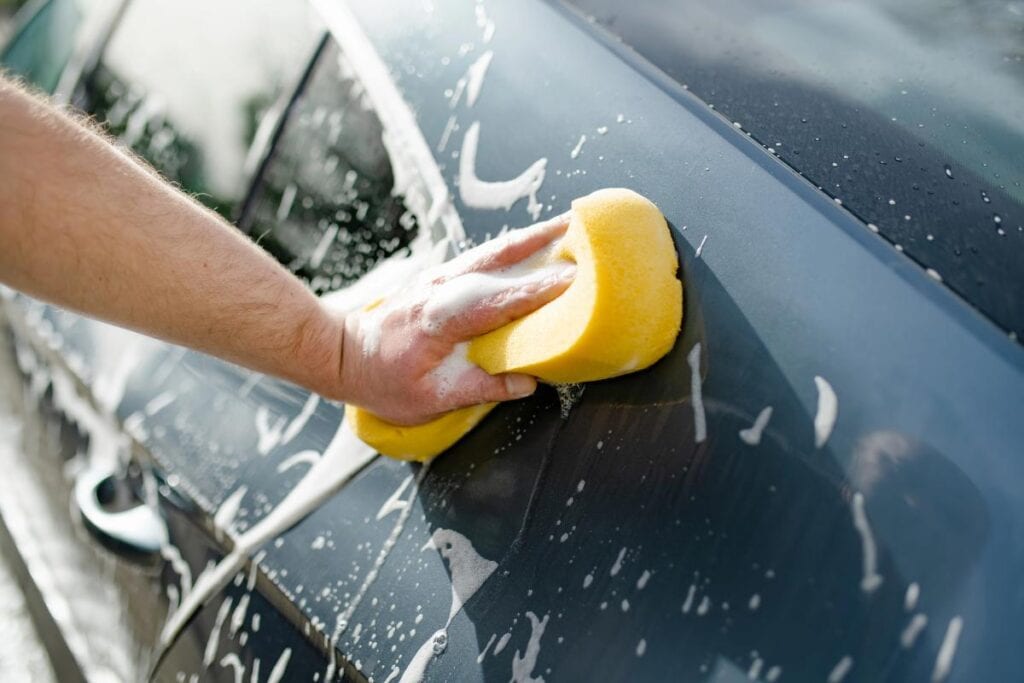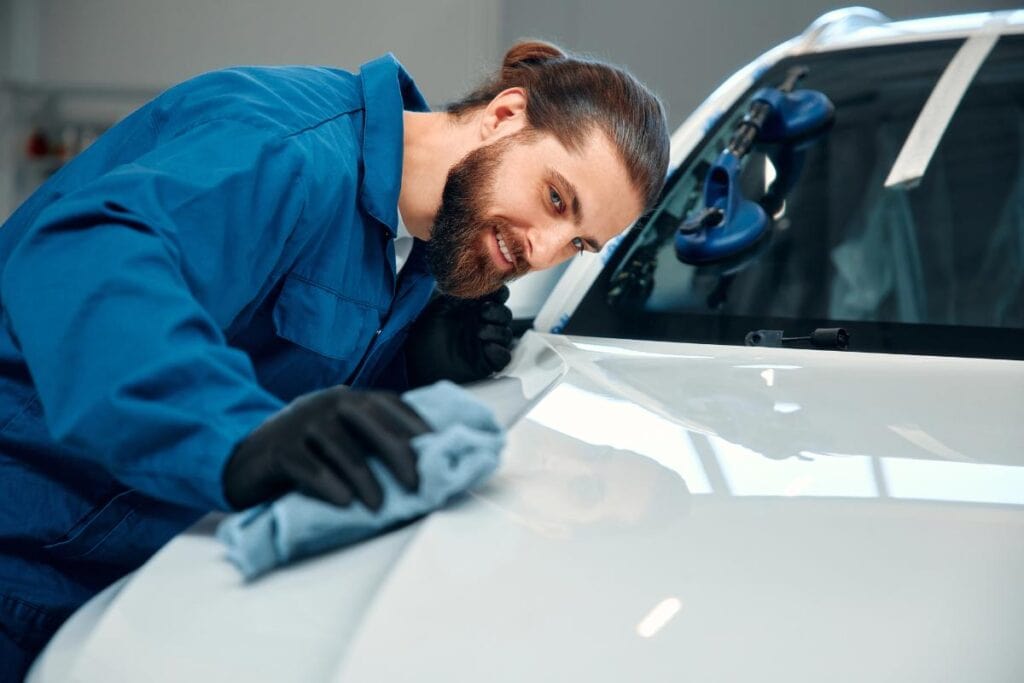
Did you know that most car owners make at least one critical mistake during their wash? These common mishaps mean that not only does your vehicle not look its best, but it can also lead to costly damage over time. From using the wrong cleaning products to neglecting essential areas, it’s easy to overlook key steps in the process. Understanding these pitfalls can save you from future headaches and keep your car looking its best. So, what should you be aware of to guarantee a proper wash?
Using Dish Soap

Many car owners make the common mistake of using dish soap to wash their vehicles, thinking it’s a quick and effective solution.
While dish soap does cut grease and dirt, it’s not formulated for automotive paint. Using it can strip away protective wax and sealants, leaving your car vulnerable to scratches, oxidation, and environmental damage.
When you wash your car with dish soap, you might notice a temporary shine, but that’s just the soap’s effect. Over time, you’ll likely see dullness and fading in your paint job.
Additionally, dish soaps often contain harsh chemicals that can harm rubber seals and plastic components, leading to costly repairs.
Instead, invest in a quality car wash soap designed specifically for vehicle surfaces.
These products are pH-balanced, gentle on your paint, and effective at removing dirt without causing damage. They often contain lubricants that help prevent scratches during the washing process.
Skipping Pre-Wash Rinse
After ensuring you’re using the right soap, don’t forget the importance of a pre-wash rinse. Skipping this essential step can lead to scratches and swirl marks on your car’s paint.
When dirt, grime, and debris sit on the surface, they can become abrasive when you start scrubbing with a wash mitt. A thorough rinse helps to loosen and remove this buildup before you apply any soap.
During your pre-wash rinse, use a hose or pressure washer to spray your car from the top down. This technique allows heavier debris to flow off the vehicle, reducing the risk of scratches.
Focus on areas that collect more dirt, like the lower panels and wheel wells.
Using Dirty Tools

Using dirty tools can drastically undermine your car washing efforts. When you use a sponge, mitt, or towel that’s covered in dirt and grime, you risk scratching your car’s paint and leaving behind unsightly streaks.
It might seem like a small oversight, but it can lead to more significant issues down the line. Here’s how to avoid using dirty tools during your wash:
- Rinse tools regularly: Make it a habit to rinse your wash mitt or sponge frequently while you clean. This helps remove dirt and debris rather than dragging it across your car’s surface.
- Use dedicated tools: Invest in high-quality washing tools specifically designed for car care. Avoid mixing them up with household cleaning items to prevent contamination.
- Inspect before use: Always check your wash mitts, brushes, and towels for any signs of dirt or damage before you start. If they’re dirty or frayed, it’s time to replace them.
Washing in Direct Sunlight
Washing your car in direct sunlight can lead to a myriad of problems that undermine your efforts and leave your vehicle looking less than pristine.
When the sun beats down on your car, it causes soap and water to dry too quickly, which can result in unsightly streaks and spots. You might think you’re saving time by washing outdoors, but you’re actually creating more work for yourself.
Moreover, the heat can cause wax and sealants to break down faster than usual, diminishing their protective properties and leaving your paint vulnerable.
The high temperatures can also make it challenging to rinse off soap completely, leading to residue build-up that dulls your car’s finish.
To avoid these issues, try washing your car in the early morning or late afternoon when temperatures are cooler.
If you must wash during the day, find a shaded area or use a car cover to protect your vehicle from the sun.
Neglecting the Wheels

When it comes to car washing, many people overlook the wheels, yet they play an essential role in your vehicle’s overall appearance. Neglecting this vital aspect can leave your car looking dirty and unkempt. It’s important to give your wheels the attention they deserve.
Here’s why you shouldn’t skip this step:
- Brake Dust Build-Up: Your wheels accumulate brake dust that can damage the finish if left untreated.
- Road Grime: Grime and dirt from the road can cling to your wheels, detracting from your car’s shine.
- Tire Health: Cleaning your tires regularly helps maintain their integrity and extend their lifespan.
To properly clean your wheels, start by rinsing them thoroughly to remove loose dirt. Use a dedicated wheel cleaner and a soft brush to scrub away grime, paying attention to the areas around the lug nuts and brake calipers.
Rinse again and dry with a microfiber towel to prevent water spots. By including your wheels in your car washing routine, you’ll enhance your vehicle’s overall look and guarantee it maintains its value.
Don’t let dirty wheels ruin your hard work!
Overusing Water
Many car owners unknowingly overuse water during the washing process, which can lead to several issues. Excessive water not only wastes a precious resource but also creates muddy runoff that can harm the environment.
You might think that drenching your car will help remove grime more effectively, but too much water can dilute your cleaning products, making them less effective.
To avoid overusing water, stick to a systematic approach. Start with a rinse to remove loose debris, then use a bucket of soapy water and a microfiber cloth. This method minimizes water usage while maximizing cleaning efficiency.
Remember to work in sections, applying soap and rinsing as you go, ensuring you don’t leave any soap residue behind.
If you’re washing your car at home, consider using a spray nozzle with an adjustable flow to control the amount of water you use. This is especially important when thinking about the Cost of Car Wash at Home in Dubai, where water usage can directly impact your utility bills.
By being mindful of your water usage, you’ll not only protect the planet but also get a better wash overall.
Forgetting Drying Techniques

After taking care to minimize water usage during your car wash, the next step is often overlooked: drying techniques. Neglecting to dry your car properly can lead to water spots, streaks, and even paint damage.
When water evaporates, it can leave behind minerals that can harm your vehicle’s finish.
To guarantee a pristine finish, remember these key drying tips:
- Use a dedicated drying towel: A microfiber or chamois towel absorbs water effectively without scratching your paint.
- Dry in sections: Work one section at a time, starting from the top and moving down. This prevents water from running over already dried areas.
- Pat, don’t drag: Gently pat the surface to absorb water instead of dragging the towel across your paint. This reduces the risk of scratches.
Using the Wrong Cloth
Using the wrong cloth for drying can spell disaster for your car’s finish. Many people reach for regular bath towels or cotton rags, but these can leave lint, scratches, or swirl marks on your vehicle’s paint.
Instead, opt for microfiber towels specifically designed for car care. They’re super absorbent and gentle, making them perfect for drying without causing damage.
When you choose a cloth, look for one that has a high GSM (grams per square meter) count. A higher GSM means it’s thicker and more effective at wicking away moisture.
Also, avoid using sponges or old, worn-out towels that may harbor dirt and debris, which can lead to scratches.
To dry your car effectively, employ a blotting technique rather than dragging the cloth across the surface. This minimizes the risk of abrasion.
Always keep separate towels for different parts of your car, like wheels and body panels. This helps prevent cross-contamination of dirt and grime.
By using the right cloth, you’ll protect your car’s finish and guarantee it looks its best for years to come.
Ignoring Waxing Needs

Neglecting to wax your car can lead to a dull finish and increased vulnerability to environmental damage.
Regular waxing not only enhances your vehicle’s appearance but also protects it from harmful elements like UV rays, bird droppings, and acid rain. By skipping this essential step, you’re risking the longevity of your car’s paint and finish.
Here are a few reasons why you shouldn’t ignore waxing:
- Protection from Contaminants: A good layer of wax acts as a barrier against dirt, grime, and harmful substances that can damage the paint.
- Enhanced Shine: Waxing gives your vehicle a glossy finish, making it look newer and well-maintained.
- Resale Value: A car that’s been regularly waxed retains its value better than one that hasn’t, making it more attractive to potential buyers.
To keep your car looking its best, aim to wax it every three months.
This simple task can save you time and money in the long run by preventing costly paint repairs.
Make waxing a part of your car care routine, and you’ll enjoy a stunning vehicle for years to come.
Not Cleaning the Interior
When it comes to car maintenance, failing to clean the interior can be just as detrimental as neglecting the exterior. A dirty interior not only affects your comfort but can also lead to long-term damage. Dirt and grime can wear down upholstery, while spilled drinks may cause stains or even mold growth if left unattended.
You might think the exterior shine is enough, but a clean interior enhances your driving experience and maintains your vehicle’s value. Start by removing trash and clutter—this simple step makes a noticeable difference.
Next, vacuum the seats, carpets, and floor mats to eliminate dust and debris. Don’t forget to get into those hard-to-reach spots, like under the seats and in between crevices.
Use appropriate cleaning products for surfaces like dashboards and leather seats to avoid damage. Wipe down with microfiber cloths to prevent scratches and streaks.
Finally, consider freshening up the air inside with an air freshener or by cleaning the vents; this can make your rides much more enjoyable.
Overlooking Regular Maintenance

While it might be tempting to focus solely on the exterior shine of your car, overlooking regular maintenance can lead to costly repairs down the line.
Regular upkeep goes beyond just washing; it’s about ensuring your vehicle runs smoothly and efficiently. Neglecting these crucial tasks can affect performance and safety, putting you at risk.
To keep your car in top shape, consider these maintenance tasks:
- Oil Changes: Regular oil changes help keep your engine clean and running efficiently.
- Tire Rotations: Rotating your tires prevents uneven wear and enhances handling, prolonging their lifespan.
- Fluid Checks: Regularly check and top off essential fluids such as coolant, brake fluid, and transmission fluid to prevent serious breakdowns.
By avoiding common car washing mistakes, you can keep your vehicle looking as fresh as a morning dew. Remember to use the right products, rinse before washing, and pay attention to every detail, including those often-missed wheels. Regular waxing and interior cleaning are just as essential for a thorough shine. With these tips in mind, you’ll not only enhance your car’s appearance but also extend its lifespan, making every drive a pleasure. Happy washing!
